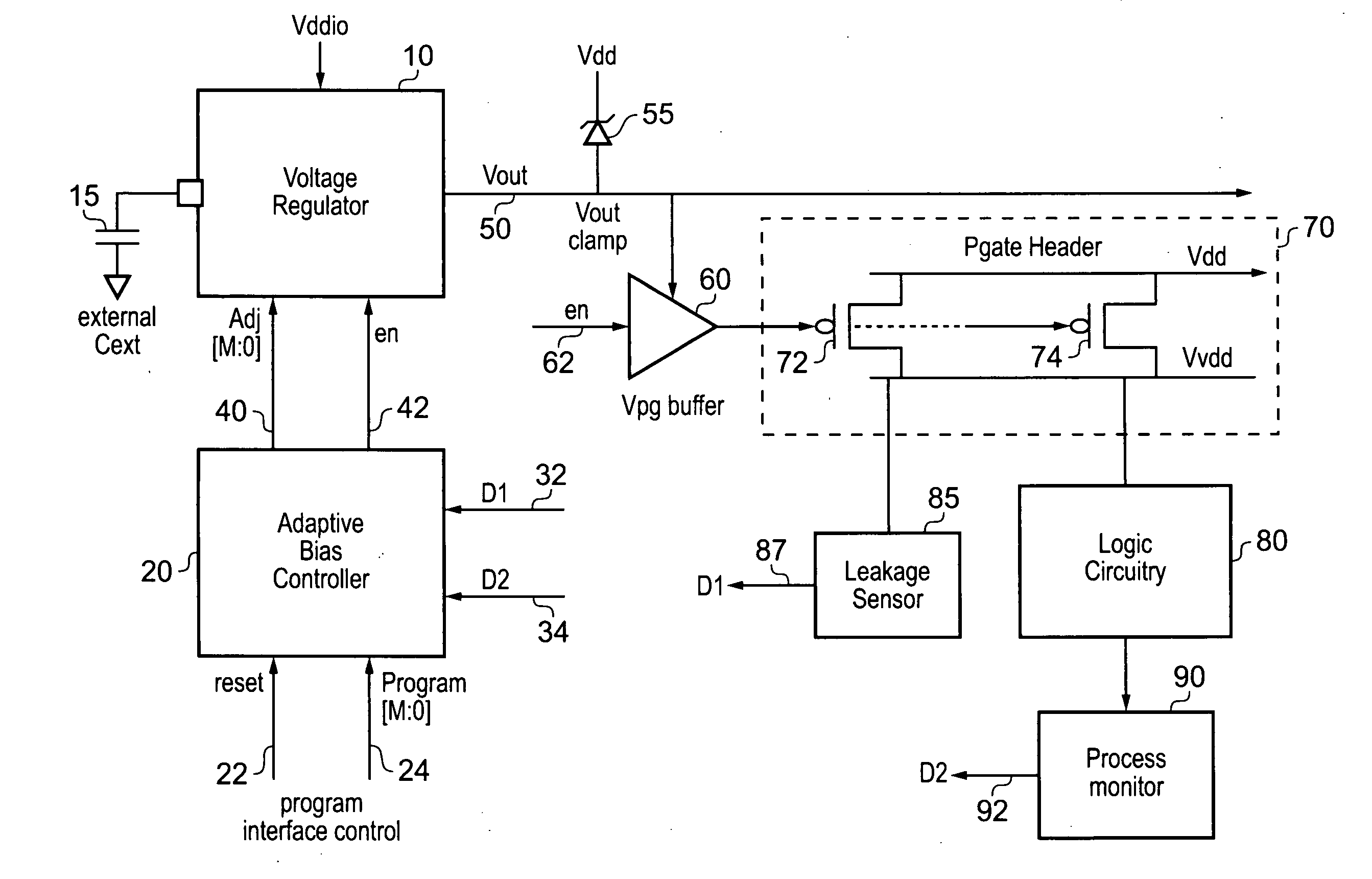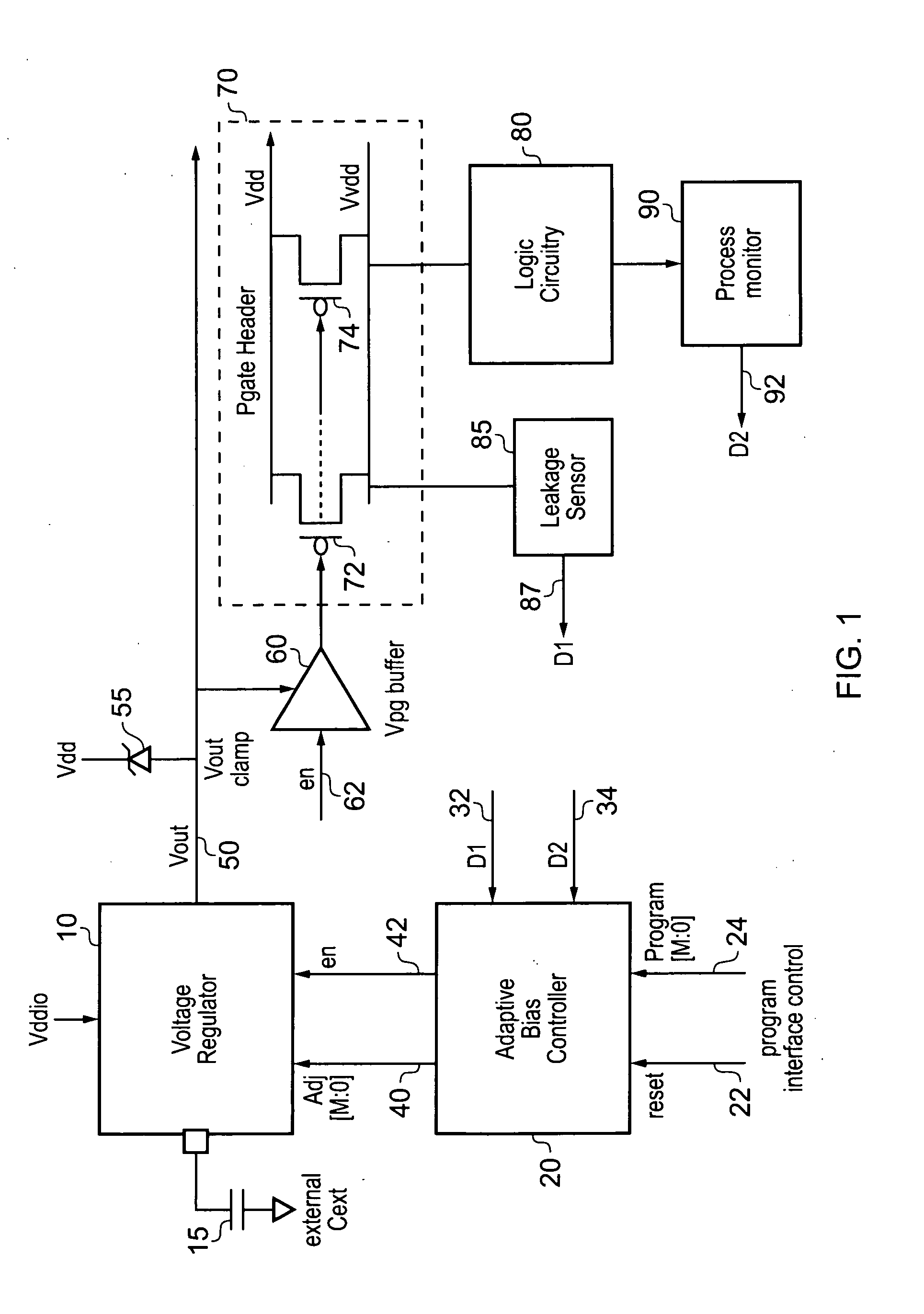[0016]Such an approach provides an adaptive technique for determining the appropriate control voltage to provide to the power gating circuitry, with the aim of reducing the leakage current to an acceptable level, whilst avoiding undue
wear out of the power gating circuitry by only providing a control voltage sufficient to achieve the desired leakage current. Through use of such a technique, the control voltage can readily be varied having regard to operating conditions. For example, the higher the
operating temperature of the integrated circuit, the greater the leakage current will be. Hence, as the
operating temperature increases, the control voltage will need to be varied to seek to bring the leakage current down to an acceptable level. Conversely, if the integrated circuit is running at a low temperature, the leakage current will be less, and may drop below a threshold level that would have been acceptable. In such cases, the control voltage can be changed in order to increase the leakage current, with the aim of reducing wear out of the components within the power gating circuitry.
[0018]Hence, in one such embodiment, when the operating parameter data indicates that the leakage current is exceeding the desired leakage current, the adaptive controller is arranged to set the
feedback control signal to a value that causes the
voltage regulator circuitry to increase the
overdrive voltage provided a maximum predetermined voltage level has not been reached. Similarly, when the operating parameter data indicates that the leakage current is below the desired leakage current, the adaptive controller is arranged to set the feedback
control signal to a value that causes the voltage
regulator circuitry to decrease the
overdrive voltage provided a minimum predetermined voltage level has not been reached. By such an approach, it can be seen that the voltage
regulator circuitry in combination with the adaptive controller serve to make the leakage current converge on a desired leakage current. Hence, excessive leakage current is prevented by increasing the
overdrive voltage, and conversely the overdrive voltage can be reduced in order to reduce wear out of the power gating circuitry when the leakage current is low enough to allow, i.e. where the leakage current is below the desired leakage current. This enables a balance to be achieved between suppressing leakage current and maximising life of the circuitry.
[0020]Whilst the desired leakage current could be specified to be a specific current value, in one embodiment the desired leakage current is specified as a range of leakage current values, thereby enabling the above described convergence to more readily be achieved.
[0021]The adaptive controller can take a variety of forms. However, in one embodiment the adaptive controller comprises a state
machine that is enabled when said low
power mode is entered, the state
machine transitioning between a plurality of states dependent on the received operating parameter data. The use of a state
machine to provide the functionalities of the adaptive controller provides a particularly efficient mechanism for achieving the required functionality of the adaptive controller.
[0028]Alternatively, or in addition, the monitoring circuits may comprise process
skew monitoring circuitry for monitoring speed of operation of the block of components during the
normal mode of operation. In particular, variations in the
silicon on which the integrated circuits are produced will mean that some circuits inherently operate more quickly than other circuits. Process
skew monitoring circuitry can determine whether a
silicon is fast
silicon (i.e. the integrated circuit is operating more quickly than the norm) or slow silicon (i.e. the integrated circuit is operating more slowly than the norm), and this information can be used to determine how to adjust the control voltage. In particular, components constructed on slow silicon have less leakage current than the same components constructed on fast silicon, and hence for an integrated circuit of the slow silicon type, a lower control voltage may be required to achieve the desired level of leakage current. By setting the control voltage to that lower level, the lifetime of the integrated circuit can be increased.
 Login to View More
Login to View More  Login to View More
Login to View More 


